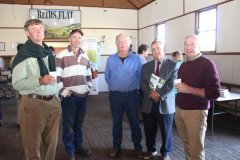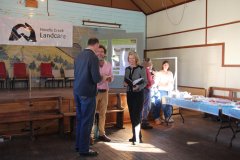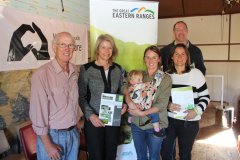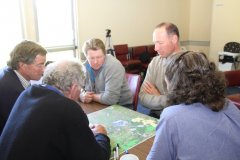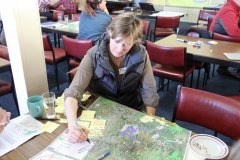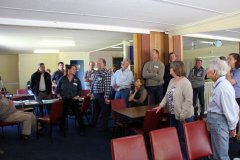Action Plan for K2W Habitat Management and Landcare (2013 – 14)
This Action Plan for habitat management and Landcare in the western sector of the Kanangra-Boyd to Wyangala (K2W) bird migration corridor was developed by the Hovells Creek Landcare Group Inc (HCLG) with funding sponsorship from the Great Eastern Ranges Initiative (GERI) and considerable input from the local community, local landholders and technical experts in wildlife and habitat management. Four key Action Themes and attenuate Action Tasks/Projects were identified:
1. Habitat management, revegetation and vegetation enhancement
The forested ridge tops of the Mt Darling and Botanical/Decca Ranges (approximately 26 000 ha) for which follow up work on access, fire management, weed and feral animal pest control is recommended. Investigation of voluntary conservation agreements and stewardship payment options for long-term protection of wildlife habitat on farmland is also recommended.
The farm zone comprising deeply dissected steep and hilly, upland country (approximately 58 500 ha) with a good remnant tree cover (at least one tree per hectare and numerous clumps of more dense vegetation), and the lower slopes and flood plains (approximately 6 100 ha) used for more intensive grazing and cropping with fewer remaining paddock trees. Recommended action for this zone includes new paddock tree planting, retention of dead paddock trees as nest sites, protecting and rehabilitating larger patches of remnant vegetation, and monitoring use of the farm zone by migratory/other birds/native wildlife.
The riverine zone (approximately 1 200 ha) along the Lachlan and Abercrombie Rivers, and Hovells and Milburn Creeks are recognised as significant drought refuges and migratory pathways for birds but require regeneration of native trees and shrubs, protection from overgrazing, and some erosion control measures.
2. Weed management
Weeds management in the sector emerged as one of the critical habitat management ‘hot topics’ and the subject of significant discussion. The key issues and actions raised include improved advisory materials for landholders, cooperative community managed bio-control programs and improved road plant and on-farm bio-security and weeds hygiene.
3. Feral Animals
Another ‘hot topic’, feral animals are of concern across the K2W corridor. Recommended action includes regional landholder collaboration on feral pig, fox and cat control, including follow-up on the Boorowa Community Landcare Group coordinated baiting program, and broader community education on the impact of feral animals on native wildlife, including dumping of domestic cats in rural areas.
4. Cultural heritage
The K2W landscape holds significant cultural heritage values, particularly for people of aboriginal descent whose ancestors would have used the river systems for food, shelter and access prior to European settlement. The loss of traditional land management practices such as traditional burning is believed to be having an impact on habitat condition and fire susceptibility of current landscapes. GERI has brought the key cultural heritage stakeholders together to develop a ‘Cultural Connections’ program to progress many of the initiatives embodied in this section of the Action Plan across the K2W corridor as a whole.
To give effect to this Action Plan the community participants have identified (self-selected) teams of land managers having common strengths, goals, strategies, and possible actions, including areas where further assistance may be required. Just under 1000 private landholders and three key managers of public lands (State Parks, National Parks and Forestry Commission) have been identified within the project area. The Action Plan highlights areas where the skills and resources are available within the community, and motivation to work both within stakeholder groups and across stakeholder groups.




